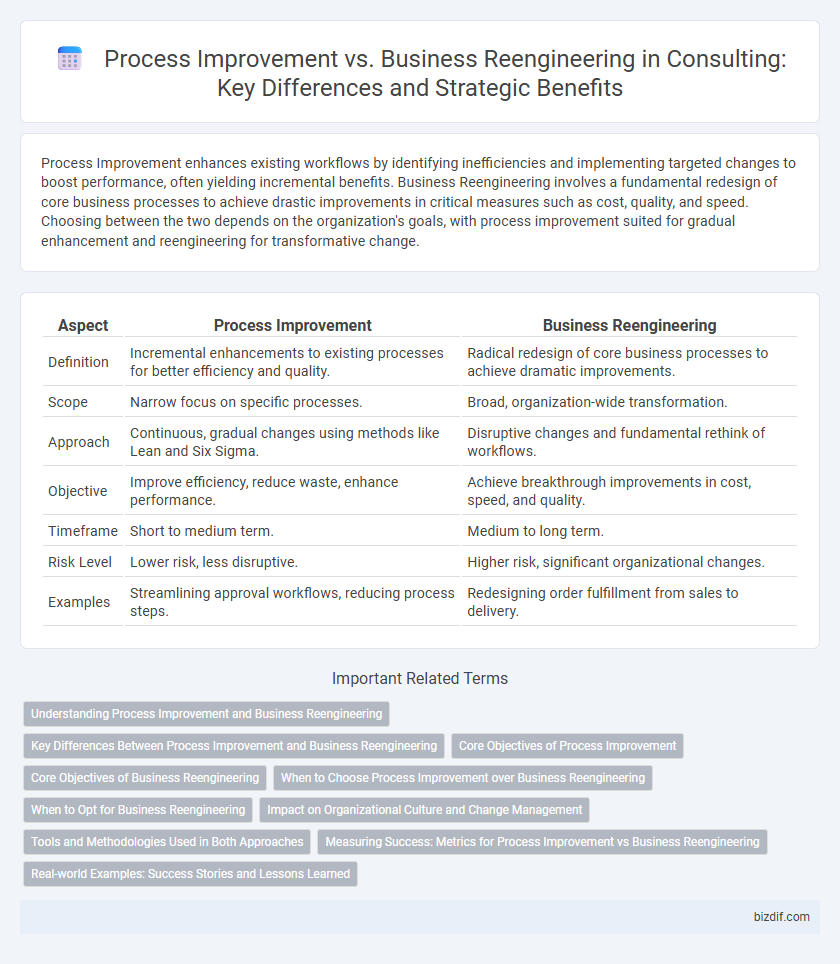Process Improvement enhances existing workflows by identifying inefficiencies and implementing targeted changes to boost performance, often yielding incremental benefits. Business Reengineering involves a fundamental redesign of core business processes to achieve drastic improvements in critical measures such as cost, quality, and speed. Choosing between the two depends on the organization's goals, with process improvement suited for gradual enhancement and reengineering for transformative change.
Table of Comparison
| Aspect | Process Improvement | Business Reengineering |
|---|---|---|
| Definition | Incremental enhancements to existing processes for better efficiency and quality. | Radical redesign of core business processes to achieve dramatic improvements. |
| Scope | Narrow focus on specific processes. | Broad, organization-wide transformation. |
| Approach | Continuous, gradual changes using methods like Lean and Six Sigma. | Disruptive changes and fundamental rethink of workflows. |
| Objective | Improve efficiency, reduce waste, enhance performance. | Achieve breakthrough improvements in cost, speed, and quality. |
| Timeframe | Short to medium term. | Medium to long term. |
| Risk Level | Lower risk, less disruptive. | Higher risk, significant organizational changes. |
| Examples | Streamlining approval workflows, reducing process steps. | Redesigning order fulfillment from sales to delivery. |
Understanding Process Improvement and Business Reengineering
Process Improvement targets incremental enhancements to existing workflows, aiming to boost efficiency, reduce waste, and optimize current processes through continuous analysis and refinement. Business Reengineering involves a radical redesign of core business processes to achieve dramatic performance improvements, often necessitating fundamental changes in organizational structure and technology. Understanding these approaches helps organizations balance evolutionary improvements with transformative change to meet strategic goals effectively.
Key Differences Between Process Improvement and Business Reengineering
Process Improvement focuses on incremental enhancements to existing workflows to increase efficiency and reduce costs, while Business Reengineering involves fundamental redesign of core business processes to achieve dramatic performance gains. Process Improvement typically employs methodologies such as Lean and Six Sigma, targeting specific areas for gradual optimization, whereas Business Reengineering requires a holistic approach, often involving technology integration and organizational restructuring. Key differences lie in scope, scale, and impact: Process Improvement is evolutionary and limited in scope, whereas Business Reengineering is revolutionary and transformative, addressing root causes rather than symptoms.
Core Objectives of Process Improvement
Process improvement targets incremental enhancements in workflows to increase efficiency and reduce waste, emphasizing measurable gains in quality and speed. Core objectives include optimizing existing processes for consistency, minimizing errors, and enhancing customer satisfaction without radical changes. This contrasts with business reengineering, which involves fundamental redesigns aimed at transformative organizational shifts.
Core Objectives of Business Reengineering
Business Reengineering focuses on radically redesigning core business processes to achieve dramatic improvements in critical performance measures such as cost, quality, service, and speed. Its core objectives include eliminating inefficiencies, streamlining workflows, and aligning processes with strategic business goals to drive transformative change. Process Improvement, in contrast, targets incremental enhancements, whereas Business Reengineering seeks fundamental shifts to create competitive advantage.
When to Choose Process Improvement over Business Reengineering
Choose Process Improvement when existing workflows require incremental enhancements to boost efficiency and reduce errors without major disruption. Process Improvement suits organizations with stable core processes aiming for continuous development through refinement, cost reduction, and quality enhancement. Opt for Process Improvement rather than Business Reengineering when operational changes need low-risk, manageable adaptations instead of radical, comprehensive redesigns.
When to Opt for Business Reengineering
Business reengineering is the optimal choice when organizations face fundamental shifts in market demands or need to overhaul outdated processes that incremental improvements cannot address. It involves radical redesign of core business processes to achieve dramatic gains in productivity, efficiency, and customer satisfaction. Opt for business reengineering when incremental process improvements fail to meet strategic goals or when competitive pressures demand transformative change.
Impact on Organizational Culture and Change Management
Process Improvement fosters incremental change by optimizing existing workflows, promoting a culture of continuous enhancement and employee engagement. Business Reengineering drives radical transformation, often requiring a significant cultural shift and robust change management strategies to overcome resistance and align teams with new organizational paradigms. Effective change management in both approaches is crucial for embedding new behaviors, sustaining improvements, and achieving long-term organizational success.
Tools and Methodologies Used in Both Approaches
Process improvement utilizes tools such as Lean, Six Sigma, and Kaizen to optimize existing workflows by identifying inefficiencies and reducing waste. Business reengineering employs methodologies like Business Process Reengineering (BPR), often supported by advanced technologies including ERP systems and process automation software to fundamentally redesign processes for dramatic performance enhancement. Both approaches leverage data analysis, process mapping, and continuous monitoring tools but differ in the scale and scope of change implemented.
Measuring Success: Metrics for Process Improvement vs Business Reengineering
Measuring success in process improvement relies on metrics such as cycle time reduction, defect rates, and cost savings to evaluate incremental enhancements in existing workflows. Business reengineering success is measured through dramatic performance shifts including revenue growth, market share increase, and overall organizational agility by fundamentally redesigning core processes. Comparing these metrics helps organizations choose between continuous improvement and transformative change based on desired impact and strategic goals.
Real-world Examples: Success Stories and Lessons Learned
Process improvement initiatives at Toyota streamlined assembly lines, resulting in a 25% reduction in production time, while business reengineering at Ford transformed the supply chain, boosting efficiency by 30%. Amazon's continuous process improvement in logistics enhances delivery speed, whereas its business reengineering efforts redefined customer experience through innovative technology integration. Lessons highlight that incremental process improvements optimize existing workflows, while business reengineering demands radical changes to achieve breakthrough results.
Process Improvement vs Business Reengineering Infographic

 bizdif.com
bizdif.com